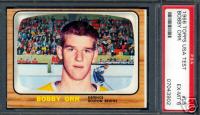Why Sportscards do better during recession years than boom years.
During unstable economic times people have been pulling their money out of investments and converting them to cash.
When people take their money out of stock investments or real estate, often coins, antiques, and movie and sports memorabilia is where much of it goes. When it comes to considering sportscards as an investment, the best thing to do is to examine the history of how things like sportscards have done in the past. Collectibles, especially coins, remain extremely liquid.
If you had invested in baseball cards for example at the end of the 1970's, and sold them all at the end of the 1980's - nothing would have given you a greater return on your money. That's right, nothing. Not even real-estate. Rare coin prices actually rose during the great depression of the 1930's, and they rose again during the recession and oil crisis of the mid to late 70's. They nearly doubled in value during the two years that followed the stock market shock of 1987. (source: PCGS 3000 Index)
Collectibles markets are often counter-cyclical to widespread turmoil, meaning owners can actually profit when they need money the most. At worst, these categories are generally only minimally affected, in the short-term, by Wall Street's wild fluctuations. Coins and collectibles have a steady record of bouncing back even if their value takes a hit. A big reason why sports cards in particular do so well, is unlike currency, stock or bond investments, once the year has passed, they don't make any more of them. So like art, they can quickly accelerate in value when they have surges in popularity.
Investing in sports cards is a hedge against inflation, and another way to diversify your money. In 1984 a 1951 Topps Mickey Mantle rookie card sold for $300. Today it sells for $3Million. Bobby Orr Rookie Cards and Wayne Gretzky rookie cards tell the same story. Once valued at $20-$50, these cards now command tens of thousands. A gem-mint O-Pee-Chee Gretzky rookie card has now sold for over one million dollars.

How to buy:
Buy rookies. Rookie cards are always the highest in demand of that player's cards and will appreciate in value the fastest.
Buy vintage. Now, this is defined by anything before 1990. Vintage rarely drops in value because a player's career is complete and the value of the cards is not affected by the ups and downs of an active career.
Buy graded. Grading is the only way to buy rare notable rookie cards. We here at Canadian Hockey Cards only like to deal in graded cards when dealing with a rookie card of a player like Wayne Gretzky. It is also a protection against counterfeit cards. The only grading companies we would consider as top level would be Beckett (BGS or BVG), PSA and SCG. Cards in grade 8 or higher condition continue to break new records in sales. But even lower grades of vintage cards continue to rise steadily. A modern Upper Deck Young Guns card needs a grade of 9 or higher to be taken seriously as an investment card.
Card condition: Centering is the most obvious flaw. Make sure the border is even on both sides and on top and bottom. Beware of a card that may have a grade of PSA 8 or PSA 9, but has an (OC) under the grade. This means the card is off-centre, and is worth less than half of what it would be if it was centered. The next priority is the sharpness of the corners. Without sharp corners, a card would have a tough time grading higher than 5 on a scale of 10. Creases will bring down the value of a card faster than anything. It is like an instant 70% reduction in the value of a card. Creases cannot always be seen in a scan of a card. They sometimes need to be turned to an angle and seen in good light to spot a crease. A crease will give a card a grading no higher than 3 out of 10.

Cards graded 7 and higher make the best investments, the exceptions would be the rarest of cards, for example a George Vezina or Cyclone Taylor tobacco card from the early 20th century. This card still appreciates in value even with a 3 grading.
Of course the above advice is for buying sportscards as an investment. If you are simply buying for pleasure with no intent of reselling at some point in the future, then there is no pressure to pick the perfect card. Nor would there be any need to buy graded cards, or to have your cards graded. You can save a lot of money buying cards that don't have great centering, or maybe have a corner that is slightly flawed, or a crease that isn't easy to notice. In that case, just having a card of a particular player means more to you than the investment potential, and your money will go a lot further. By Thomas Clemmer - Canadian Hockey Cards